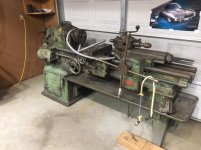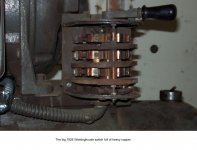I have a 6' bed version of this lathe. It's 2-H turret lathe. I have a thread on mine here:
South Bend No. 2-H Turret Lathe 16"x6' Restoration
Your electric motor should be using two drum switches on back side. That's because each drum switch has three positions. Off in center position, than each side can swap how each of the 3 leads connect to motor. One switch can do high and low, one reverse, though not necessarily in that order. Side note, that is a two speed motor, a regular 3 phase motor won't give you high and low speeds and is wired a little different.
Since your fwd is working, the motor should be fine. Reverse is just swapping any two, of the three leads for the high speed wiring, or any two for the low speed wiring. Depends if you want reverse to be high or low speed. My reverse is high speed, as thats just how it was wired when I got it. If you got a multimeter, check voltage between any two legs to read rated voltage, guessing 208-220v. by process of elimination, check voltage at all three legs, two at a time, to figure out which leg is missing voltage. at motor, before and after the switch, etc. But I would guess one leg has a bad connection at switch, or a broken wire. Try reading motor data tag as well, just to insure you're using correct voltage.
You're right about the needing to lube. There's more lube points on this than you can imagine. Including the pulley assembly in motor housing directly above electric motor, should have cups on both end bearings. That turret end has a ton of lube points all over, as well as the whole machine. Pretty much anything that moves. You'll be using a thumb press oil can quite a bit. I'd change the oil in apron and turret gear box at a minimum too, if you're not intending on tearing the machine down for a good cleaning.
That rod hanging down from chip pan, plus the light switch on the leg of tail stock end, tells me it originally had factory coolant set up. Do you have the coolant tank or mounting bracket for it ? If you don't might check again from where you got it. You'll probably see a drain in chip pan hidden inside the pedestal that hold bed up as well.
Another fyi, you won't really use reverse too much if ever, but nice having options. Just keep in mind, the back plate which looks like is part of the chuck, chuck bolts to it, well the back plate is threaded onto to spindle. In reverse, with enough torque to whatever you're doing, it is possible for the chuck with back plate to unscrew right off the spindle. Now if chuck and back plate haven't been off in 20 years, that'll probably never happen, just keep eye on chuck real good when reversing with electric motor.








